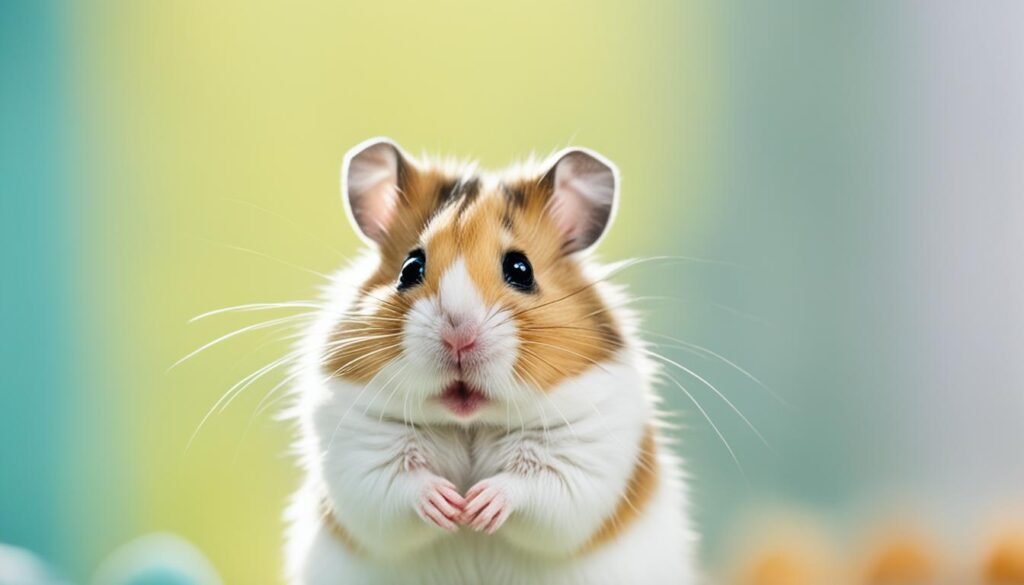Have you ever wondered about the visual capabilities of hamsters? While these small furry creatures may seem cute and curious, their eyesight is quite different from our own. So, just how far can a hamster see?
When it comes to hamster vision, it’s important to note that these nocturnal creatures have poor eyesight compared to humans and other animals. While they are not blind, they rely on their other senses, such as smell and hearing, to navigate their environment.
Hamsters have nearsighted vision and are colorblind. Their eyes are equipped with 97% rod and 3% cone receptors, which means they can only see a few inches in front of their noses. They perceive the world in black, white, and shades of green.
Despite their limited visual acuity, hamsters have a wide field of view and can see better in dim light. However, in bright light, they are almost completely blind. This poor eyesight makes them rely heavily on their sense of smell and hearing to compensate for their visual limitations.
Now that you know about the unique vision of hamsters, let’s explore the impact of their poor eyesight on their behavior and how understanding their eye anatomy can shed more light on their visual capabilities.
The Impact of Poor Eyesight on Hamsters
Hamsters’ poor eyesight can have significant implications for their behavior and overall well-being. Due to their limited vision, hamsters can easily become startled by sudden movements, which can result in defensive biting behavior. Additionally, their poor eyesight may cause difficulty in recognizing their owners or distinguishing objects at a distance.
Poor eyesight can pose challenges for hamsters when it comes to navigating their environment, finding food, and avoiding potential predators. Without clear visibility, they may struggle to locate essential resources and may become more vulnerable to harm. Owners must be aware of these limitations and take measures to provide a safe habitat for their pets, minimizing risks and ensuring their hamster’s well-being.
To mitigate the impact of poor eyesight on hamsters, it is recommended to avoid multi-level cages that can be confusing to navigate. Instead, opt for spacious enclosures with simple layouts to facilitate easier movement. Additionally, ensuring that the hamster’s environment is free from potential hazards and obstacles can help prevent accidental injuries.
By understanding the effects of poor eyesight on hamsters and making necessary adjustments to their habitat, owners can create a conducive and safe living space for their furry companions. This proactive approach promotes the overall welfare and happiness of hamsters, enabling them to thrive in their captivity.

Understanding Hamster Eyesight
Hamsters have poor eyesight due to several factors, including their adaptation to living in low light conditions and their unique eye anatomy. As small, nocturnal creatures, hamsters have evolved to thrive in dim environments, which has resulted in compromised visual capabilities. Their eyes are small and round, positioned on the sides of their heads, allowing for a wide field of vision but limiting their ability to see details.
Unlike humans, hamsters are born blind and gradually develop their eyesight as they grow. However, even as adults, their vision remains limited, with the ability to see only a few inches in front of them. Hamsters’ eyes are not equipped to focus light as effectively as human eyes, leading to blurry and distorted images. This explains their difficulty in recognizing objects or distinguishing finer details.
In response to their poor eyesight, hamsters rely heavily on their other heightened senses, particularly their sense of smell and hearing. These senses serve as compensatory mechanisms that help hamsters navigate their surroundings, find food, and detect potential threats. Their acute sense of smell and excellent hearing abilities play a vital role in their overall perception of the environment.
While hamsters may have limited eyesight, it is important to provide them with a safe and enriched habitat that takes into account their unique visual abilities. Ensuring their living space is free of obstacles and potential hazards can prevent injuries and help them navigate more easily. Additionally, offering a variety of scents and sounds can stimulate their other senses and provide mental enrichment.
